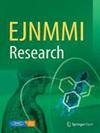Characterization of a novel model for atherosclerosis imaging: the apolipoprotein E-deficient rat
IF 3.1
3区 医学
Q1 RADIOLOGY, NUCLEAR MEDICINE & MEDICAL IMAGING
引用次数: 0
Abstract
The apolipoprotein E-deficient (apoE−/−) mouse is a well-established model for studying atherosclerosis. However, its small size limits its use in longitudinal positron emission tomography (PET) imaging studies. Recently, the apoE−/− rat has emerged as an alternative. With this study, we investigate the feasibility of using apoE−/− rats as an in vivo model for longitudinal atherosclerotic PET/CT imaging. ApoE−/− rats showed significantly higher [18F]FDG uptake than controls in the aortic arch (+ 18.5%, p < 0.001) and abdominal aorta (+ 31.0%, p < 0.001) at weeks 12, 26, and 51. ApoE−/− rats exhibited hypercholesterolemia, as evidenced by plasma cholesterol levels that were up to tenfold higher, and total hepatic cholesterol levels that were up to threefold higher than the control rats at the end of the study. Fast protein liquid chromatography cholesterol profiling indicated very high levels of pro-atherogenic apoB-containing very low-density lipoprotein and low-density lipoprotein fractions in the apoE−/− rats. Atherosclerotic lesions cover 19.9% of the surface of the aortic arch (p = 0.0013), and there was a significantly higher subendothelial accumulation of ED1-positive macrophages in the abdominal aorta of the apoE−/− rats compared to control rats (Ctrl) (p = 0.01). No differences in neutral sterols were observed but higher levels of bile acids were found in the apoE−/− rats. These data demonstrate early signs of hypercholesterolemia, high levels of bile acids, the development of atherosclerotic lesions, and macrophage accumulation in apoE−/− rats. Therefore, this model shows promise for atherosclerosis imaging studies.动脉粥样硬化成像新模型的特征:脂蛋白 E 缺乏大鼠
载脂蛋白 E 缺乏(apoE-/-)小鼠是研究动脉粥样硬化的成熟模型。然而,小鼠体型小,限制了它在纵向正电子发射断层扫描(PET)成像研究中的应用。最近,apoE-/-大鼠成为了一种替代品。通过这项研究,我们探讨了使用载脂蛋白E-/-大鼠作为纵向动脉粥样硬化 PET/CT 成像体内模型的可行性。在第 12、26 和 51 周,载脂蛋白 E-/- 大鼠主动脉弓(+ 18.5%,p < 0.001)和腹主动脉(+ 31.0%,p < 0.001)的 [18F]FDG 摄取量明显高于对照组。载脂蛋白E-/-大鼠表现出高胆固醇血症,表现为研究结束时血浆胆固醇水平比对照组大鼠高十倍,肝脏总胆固醇水平比对照组大鼠高三倍。快速蛋白液相色谱胆固醇分析表明,载脂蛋白 E-/- 大鼠体内含有极低密度脂蛋白和低密度脂蛋白组分的促动脉粥样硬化载脂蛋白水平非常高。动脉粥样硬化病变覆盖了主动脉弓表面的 19.9%(p = 0.0013),与对照组大鼠(Ctrl)相比,apoE-/-大鼠腹主动脉内皮下堆积的 ED1 阳性巨噬细胞明显较多(p = 0.01)。未观察到中性固醇的差异,但发现载脂蛋白 E-/- 大鼠胆汁酸水平较高。这些数据表明载脂蛋白 E-/- 大鼠出现了高胆固醇血症的早期症状、高水平的胆汁酸、动脉粥样硬化病变的发展和巨噬细胞的积累。因此,该模型有望用于动脉粥样硬化成像研究。
本文章由计算机程序翻译,如有差异,请以英文原文为准。
求助全文
约1分钟内获得全文
求助全文
来源期刊

EJNMMI Research
RADIOLOGY, NUCLEAR MEDICINE & MEDICAL IMAGING&nb-
CiteScore
5.90
自引率
3.10%
发文量
72
审稿时长
13 weeks
期刊介绍:
EJNMMI Research publishes new basic, translational and clinical research in the field of nuclear medicine and molecular imaging. Regular features include original research articles, rapid communication of preliminary data on innovative research, interesting case reports, editorials, and letters to the editor. Educational articles on basic sciences, fundamental aspects and controversy related to pre-clinical and clinical research or ethical aspects of research are also welcome. Timely reviews provide updates on current applications, issues in imaging research and translational aspects of nuclear medicine and molecular imaging technologies.
The main emphasis is placed on the development of targeted imaging with radiopharmaceuticals within the broader context of molecular probes to enhance understanding and characterisation of the complex biological processes underlying disease and to develop, test and guide new treatment modalities, including radionuclide therapy.
 求助内容:
求助内容: 应助结果提醒方式:
应助结果提醒方式:


